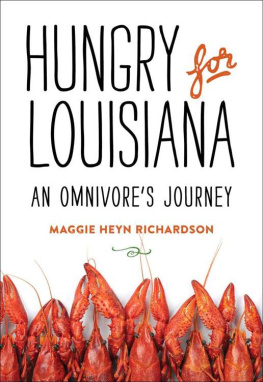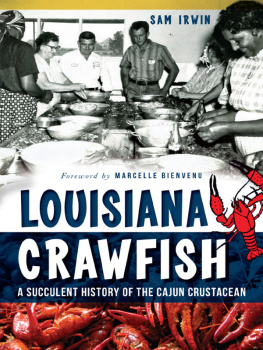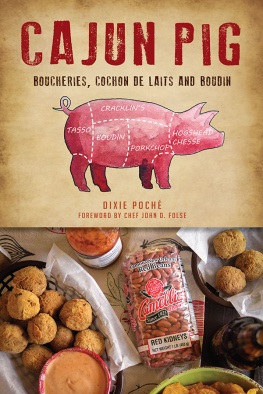HUNGRY for
LOUISIANA
HUNGRY for
LOUISIANA
AN OMNIVORE'S JOURNEY
MAGGIE HEYN RICHARDSON
ILLUSTRATIONS BY ELIZABETH RANDALL NEELY

LOUISIANA STATE UNIVERSITY PRESS
BATON ROUGE
Published with the assistance of the Borne Fund
Published by Louisiana State University Press
Copyright 2015 by Louisiana State University Press
All rights reserved
Manufactured in the United States of America
FIRST PRINTING
DESIGNER: Mandy McDonald Scallan
TYPEFACE: Whtiman
PRINTER AND BINDER: Maple Press, Inc.
Library of Congress Cataloging-in-Publication Data
Richardson, Maggie Heyn, 1969
Hungry for Louisiana: an Omnivore's journey / Maggie Heyn Richardson; illustrations by Elizabeth Randall Neely.
pages cm
ISBN 978-0-8071-5835-7 (cloth: alk. paper) ISBN 978-0-8071-5836-4 (pdf) ISBN 978-0-8071-5837-1 (epub) ISBN ) 978-0-8071-5838-8 (mobi) 1. Cooking, AmericanLouisiana style. 2. Food industry and tradeLouisiana. 3. Food habitsLouisiana. I. Title.
TX715.2.L68R53 2015
641.59763dc23
2014047033
The paper in this book meets the guidelines for permanence and durability of the Committee on Production Guidelines for Book Longevity of the Council on Library Resources.
FOR JOHN
CONTENTS
ACKNOWLEDGMENTS
First, sincere thanks goes to the many friends, acquaintances, and strangers in this magical, peculiar place who filled my head with story ideas over the more than two decades I have lived here, even if they didnt realize it.
I am deeply grateful to my editor at the Louisiana State University Press, Alisa Plant, for her ability to extract workable ideas around our mutual joy, Louisiana food, and to ease my neuroses and make the book-writing process so enjoyable. Thanks to Poppy Tooker for superb content suggestions and for Creole cream cheese details. I am also in John T. Edge's debt for his support and encouragement in the project's first stages. The Southern Foodways Alliance at the University of Mississippi provided excellent oral history on Louisiana food producers. Historian and author Sara Roahen's work on boudin was especially helpful, as were Cynthia Lejeune Nobles's chapters in New Orleans Cuisine: Fourteen Signature Dishes and Their Histories and James Q. Salter's Zwolle, Louisiana; Our Story.
Thanks to scholars Wayne Parent and Ryan Orgera for inviting me to write the food chapter in their book The Louisiana Field Guide (LSU Press, 2014), a process that helped shape this project. Thanks to Wayne and to former LSU College of Humanities and Social Sciences dean Gaines Foster for making me part of their class on southern identity at LSU.
Research for this project relied on busy people sharing their time and expertise with me. Heartfelt thanks go to Sam Irwin, Elizabeth Hill, Cheramie Sonnier, Aaron Melancon, Ray McClain, Dean Wilson, Jody Meche, Bill Pizzolato, Hal Bailey, Louis Marien, Carl Verzwyvelt, Jody Elisar, Jackie Loewer, Steve Linscombe, Celeste Dolan, Robbie Trahan, Scott Duplechein, Isaac Toups, Angela Vercher, Edward Braud III, Audrey Braud, Katie Mauthe Cutrer, Kenny Mauthe, Jamie Mauthe, John Folse, Ashley Hansen, Don Elbers, Ronnie Sciortino, Victoria Moseley Bayless, Donna Black, Claude Black, Lionel Key, Earl Gaudet, Jack Losso, Dudley Passman, Lester Bourgeois, Donald Bourgeois, Beau Bourgeois, Calvin Hue, Chris Derocher, Bob Carriker, Jim Jenkins, Larry Babineaux, Rodney Babineaux, Ginger Box, Bernie Box, Kathleen E. R. Smith, Judy Garcia, Ethel Diener, Rebecca Loupe, Quinn Bowermeister, Lee Anne Garner, Jason Gilfour, Jarod Voisin, Patrick Banks, and the late Mike Voisin.
Sara Bongiorni and Blake Newton took time to read and edit chapters. Sara Murphy and Betty Schroeder enthusiastically tested recipes. Belle Blanchard Newton spent countless hours over several months providing invaluable comments on the entire manuscript. Stafford Wood, Kate Metcalf, and Mary Kneeland Metcalf provided helpful insight into the book's marketing. Thank you.
I am grateful to my Blanchard aunts, uncles, and cousins for their consistent loyalty and support. Thanks to my father and stepmother, Christopher and Gail Heyn, for their love and for fostering my lifelong appreciation for a well-told story. Before, during, and after the project, my mother-in-law, Helen Richardson, was always ready to babysit and share her good cheer. Thanks to my late stepfather, Jerry Smith, for ceaseless grace and optimism. And Im forever in debt to my mother, Peggy Blanchard Smith, who still teaches me writing's most important lesson, to listen.
Finally, thanks to my children, Marien, Christopher, and Mercer Richardson, fonts of entertainment, affection, and inspiration, and to my husband, John Richardson, who understands big dreams and embodies generosity. I can never repay the four of them for diffusing my shortcomings with their patience and devotion and for making life one delicious ride.
HUNGRY for
LOUISIANA

INTRODUCTION
Bayou State of Mind
I fell headlong into Louisianas seductive food culture after moving to the state in the early nineties to attend graduate school at Louisiana State University (LSU) in Baton Rouge. Growing up in Georgia, I was raised with a deep appreciation for the signature foods of my corner of the world: fried chicken, boiled peanuts, peach cobbler, and pork-centric pit barbecuefoods that also happened to be claimed by other parts of the southern United States. Louisianas culinary texture, I quickly learned, was markedly different. At every turn, I found unusual flavors and preparation methods that had little in common with the rest of the South. But even more noticeable was foods heightened social significance. As it does across the globe, the traditions of the table cemented the bond between family and friendsbut in the Bayou State, food was also the clockwork that set life to an insistent rhythm.
I first arrived in Baton Rouge in the spring, when crawfish season was well underway, and it didnt take long to see how this annual event established a shared recreational pattern. As newcomers do, I scored numerous invitations to crawfish boils where friends and acquaintances gathered around newspaper-covered tables piled with scarlet mudbugs poured from giant aluminum pots. There always seemed to be a crawfish boil happening somewhere, giving a greenhorn like me ample opportunity to master the art of extracting tail meat from the small crustaceans shell. I adored its sweet-spicy flavor and tender texture, and the sensation of a cold beer chaser. But what I loved more was the comfort of being locked in a common purpose with others who, regardless of lifes pressing demands, were taking time to laugh, listen, and savor the seasonal bounty.
Crawfish boils only scratched the surface of Louisianas food rituals. On Mondays, red beans and rice pervaded restaurant menus throughout the statea New Orleans custom stemming from washday Mondays, when working women needed a one-pot meal that simmered unattended. Fall meant heading to LSUs Tiger Stadium for communal meals served by friendly, passionate fans. And every sixth of January, on the Feast of the Epiphany, rectangular boxes holding the first of the seasons Mardi Gras king cakes emerged in grocery stores and bakeries. For the next several weeks until Ash Wednesday, I, and everyone I knew, scooped up these cinnamon-strewn pastry rings iced in shades of purple, green, and gold and brought them home, to school, or to the office. The lucky person served the slice with the plastic baby Jesus tucked inside was responsible for bringing the next king cakea practice that says more about the need for sustained celebrations here than it does about piety.
Next page












